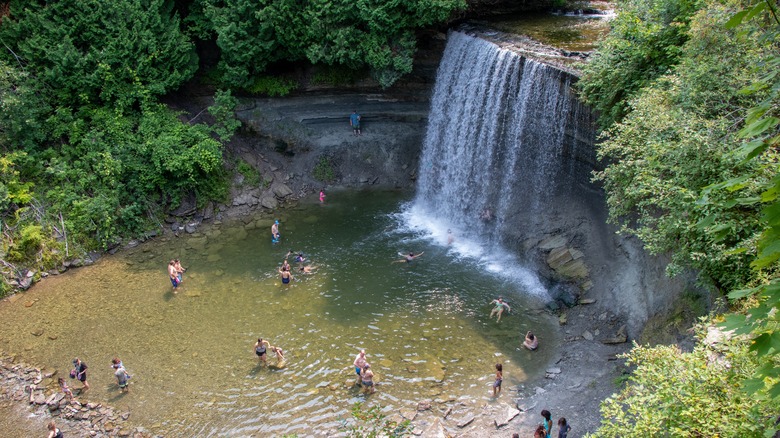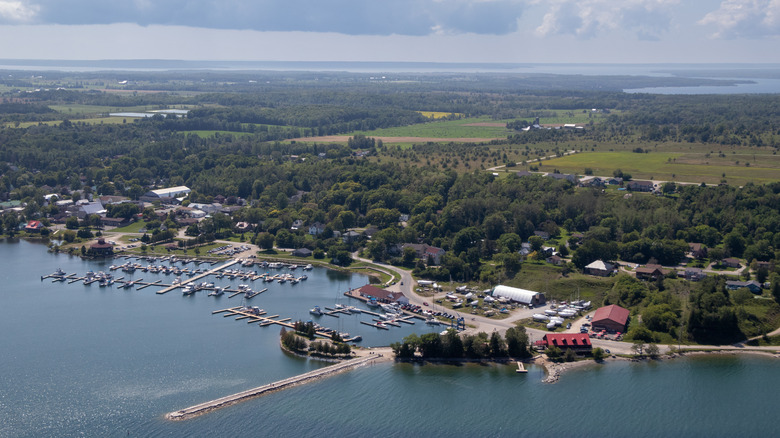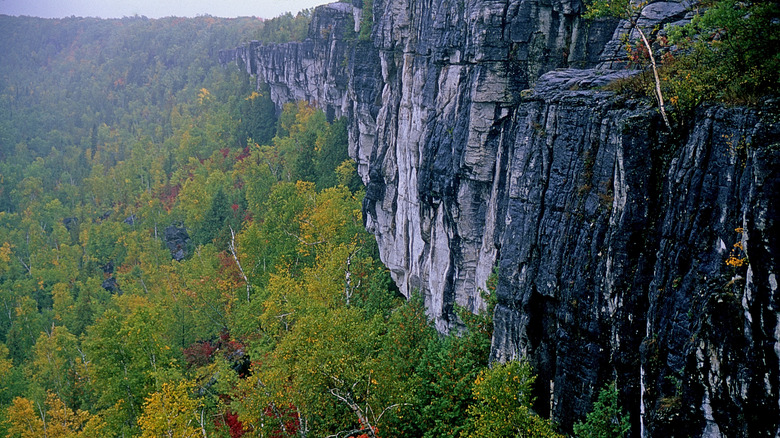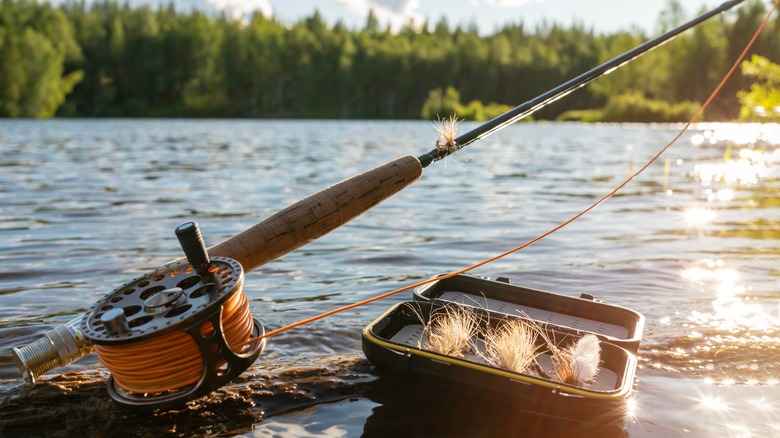Explore The World's Largest Freshwater Island For Unforgettable Outdoor Adventures
As you stand on its banks, looking up at that shimmering cascade of water, you'll see why it's called Bridal Veil Falls. At 36 feet wide, this waterfall truly looks like a gauzy piece of fabric draped over the rock face. Then you approach and discover its secret: the path continues under the falls. You have to be careful, traversing this narrow, spray-slicked ground on foot, but you can actually stand back there and look at the world through a 111-foot-tall wall of pouring water.
Bridal Veil Falls is just one of the mystical sights on Manitoulin Island, a little-known landmass in the northern reaches of Lake Huron. Manitoulin has always been something of an outlier; most of the island belongs to the Canadian province of Ontario, and the closest city is Sudbury, a rebounding mill town about two hours away by car. Looking at a map, you'd never guess that Manitoulin is the largest freshwater island in the world, measuring 100 miles at its widest points. The area hosts hiking, camping, and fishing, and it's home to a thriving Indigenous community. With attractions as majestic as Bridal Veil Falls, it's no wonder the Ojibwe people called this place Spirit Island. This is one spot Americans might add to their road trips across Canada.
Escape to this little known corner of Lake Huron
You can reach Manitoulin Island from mainland Ontario by driving south on Highway 6 until you cross the Little Current Swing Bridge, which guides you to Nemi, the largest town on the island (population 1,200). The old trestle is slated to be replaced, but travelers should still have the ability to drive to the island as construction commences. While you could theoretically fly into the Gore Bay Airport or even sail a boat into the Gore Bay Marina, most visitors will take a car, as this will enable you to explore Manitoulin's vast, undeveloped countryside.
Of its many hiking trails, the most compelling is Cup and Saucer, a rigorous 3-mile climb up a series of cliffs. Ascend the rock faces on handmade wooden ladders, then take in a horizon-wide view of Manitoulin's lush woodlands. You can also set up your tent on established sites and bring your (leashed) dog along. In a province famous for its level landscape — a glaciated flatland known as "the Canadian Shield" — Cup and Saucer is a rare chance to climb above it all. The island is also popular among motorcyclists, who can take advantage of long, rural roads with light traffic. However you enjoy your outdoors, consider finishing the day with an IPA at Manitoulin Brewing Company in Little Current or Split Rail Brewing Co. in Gore Bay. These tiny communities are among the many great towns to visit on the Great Lakes.
A resilient Indigenous enclave
The western part of Manitoulin is known as the Wiikwemkoong Unceded Territory, an important name in the history of the island. The Indigenous inhabitants of Manitoulin were a league of several tribes called the Anishinabek, and despite nearly 400 years of colonial pressure, the residents of Wiikwemkoong have never officially forfeited their lands to Canada (or any other modern nation). While the political history of Wiikwemkoong is complicated, the area is open to tourism and eager to educate visitors about Indigenous culture.
There's the biodiverse Bebamikawe Memorial Hiking Trail, a gift shop selling handmade crafts, and an Annual Cultural Festival, with traditional garments, music, and food. Numerous Anishinabek powwows take place each summer, and respectful visitors may earn the chance to attend. If you want to stay the night, the Bayside Resort provides modern log cabins with views of the water and full kitchens.
Fun on the water
Lake Huron is a magnet for boaters, and a sailor could spend weeks harnessing local winds and exploring the remote shores and inlets of the third-largest Great Lake. There are many places to lay anchor as well, including the Gore Bay Marina, with no fewer than 221 slips and room for boats up to 100 feet long. You can walk into downtown Gore Bay and enjoy pubs, restaurants, and other small-town amenities.
Incredibly, Manitoulin is large enough to have its own inland waterways, including four rivers and 108 freshwater lakes (and yes, you read that correctly). This network of freshwater habitats makes the island popular among anglers, who can cast reels all summer long. In the winter, ice fishers bore holes through the lakes' frozen crust. Note that any form of angling on the island or Lake Huron requires an Ontario Fishing License.
Manitoulin also boasts nine lighthouses and six on nearby islands, which have long prevented mariners from running aground on Huron's rocky northern shores. Most of these lighthouses are small and over a century old, and you can reach them by road. A larger specimen is the Janet Head Lighthouse, which has stood in the north-central part of the island since 1879 and looks like an actual house. Like so much of Manitoulin, it's a beautiful sight, whether you're looking from the land or the water. You should also check out this underrated city without crowds on Lake Huron's shores.



